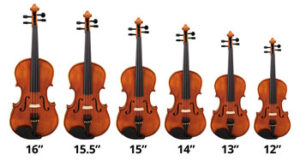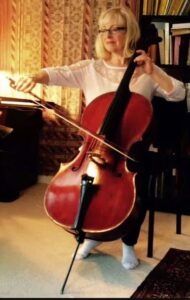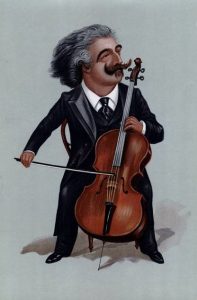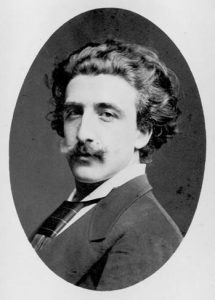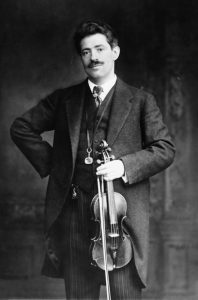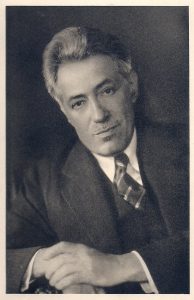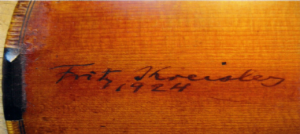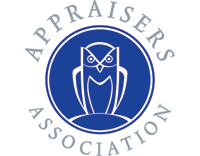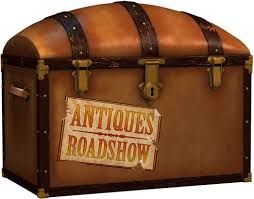Violas: The Origin of the Modern Violin Family
By: Andrew Dipper and Anika Barland
The Lira da Braccio from the 1500’s is considered by many to be the origins of the modern violin family. In his study on the development of bowed strings in North Italy from 1480-1580, Laurence Witten states, “…the Violin family, which should really be called the Viola family, because nearly all the earliest instruments of the type [with four corners] appear to have been very large violas” (Witten). In this newsletter, we will discuss the origins of this instrument, an example from the courts of King Henry II of France, and a reconstruction Andrew Dipper has made, inspired by the work of Andrea Amati.
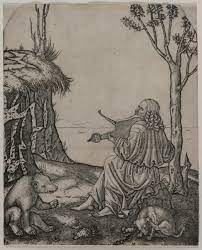 A 1505 depiction of Leonardo da Vinci shows him with a lira da braccio. It is known that Da Vinci visited the Duke of Milan in 1494 and was fond of this instrument. He crafted this lira with his own hands and was said to surpass all the musicians who had come to the court to play.
A 1505 depiction of Leonardo da Vinci shows him with a lira da braccio. It is known that Da Vinci visited the Duke of Milan in 1494 and was fond of this instrument. He crafted this lira with his own hands and was said to surpass all the musicians who had come to the court to play.
The design of the Lira da braccio fell out of common practice in the early 17th century, Witten theorizes, due to the plagues of the 1630s. The viola da braccio also fell out of common practice at this time, though it is recorded to have had a brief resurgence from 1685 to about 1730, “when a comparatively small and short-lived demand for viols seems to have been constructed in Italian court orchestras by northern music and/or musicians” (Witten).
The presence of drones on the lira da braccio is what differentiates it from the viola da braccio. While both instruments remained in use, the viol was popular in court and domestic playing during the Renaissance and Baroque periods. It was from the designs of the lira da braccio that we have the modern-day violin family.
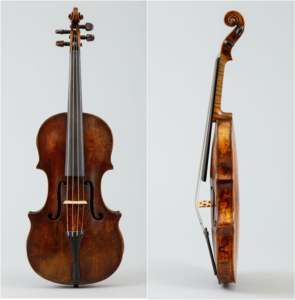 One of the earliest known lira da braccios is currently in the collections of the National Music Museum. While this lira da braccio was
One of the earliest known lira da braccios is currently in the collections of the National Music Museum. While this lira da braccio was
converted into a modern playing viola, it retains designs from the 1550s French Court. Traces of the original coat of arms from King Henry II of France are visible on the back. The Henry II motto “DONEC TOTVM IMPLEAT ORBEM” is painted on the ribs. This translates to “Til He Replenish the Whole World.” The National Music Museum has this instrument cataloged as a quinton; we believe originally it was a lira da braccio.
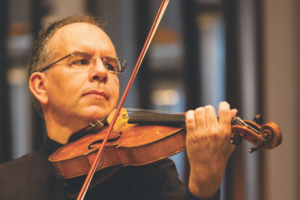
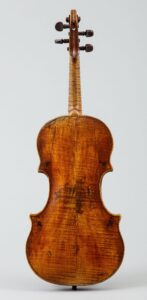 This instrument, dated to the 1550s, was played by Dr. Gerald Gaul when it was first acquired by the National Music Museum. I asked Dr. Gaul what his experiences were like playing this instrument:
This instrument, dated to the 1550s, was played by Dr. Gerald Gaul when it was first acquired by the National Music Museum. I asked Dr. Gaul what his experiences were like playing this instrument:
“I had a wonderful experience with the Henry II! It had been adapted into a viola in the eighteenth century and it was set up with modern strings. I remember that it had a very powerful voice and was very responsive. I remember thinking that it was like the instrument was alive. Later, Claire and Andrew found me another viola that was cut down from a lira da braccio. It had been made in 1590 and cut down to viola size in 1770. It has the same powerful voice and quick responses. I use it as my early music viola.”
Andrew Dipper has recreated what this original lira da braccio would have looked like in the French Courts of King Henry II. I asked him some questions about the process.
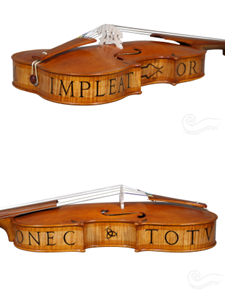 AB: Where did the inspiration to build a reconstruction for this lira da braccio come from?
AB: Where did the inspiration to build a reconstruction for this lira da braccio come from?
AD: From a discussion with Arian Sheets, Curator, at the NMM South Dakota, who was the initial owner of the Henry II viola. There were obvious changes to the outline of the instrument, and these had to be addressed so that we could determine what the instrument was in its first iteration. The best way to do this was to attempt a reverse entropic copy.
AB: What considerations were important for this project? 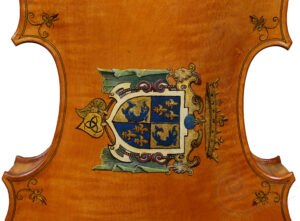
AD: The position of the armorial on the back, relative to the cc bout and the length of the decoration on the rib garland, plus the original rib height.
AB: How does this lira represent the lineage of the early violin family?
AD: It is the precursor to the family of five violin family instruments that were arranged and made in predetermined pitches to make an orchestra of voices, like a choir. This orchestra of matched voices was used to perfection in Monteverdi’s Orfeo. https://baroque.boston/monteverdi-lorfeo
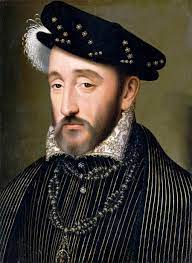 The story of this lira da braccio is interesting and continues to gather data and opinion. There are a few theories regarding the reason for this viola being commissioned. The first that it came to France for the 1559 marriage celebration between King Henry II’s daughter Elisabeth of Valois, to King Phillip II of Spain. The second is that this was commissioned by Catherine de Medici, wife of King Henry II, for the Fête at Bayonne in 1565.
The story of this lira da braccio is interesting and continues to gather data and opinion. There are a few theories regarding the reason for this viola being commissioned. The first that it came to France for the 1559 marriage celebration between King Henry II’s daughter Elisabeth of Valois, to King Phillip II of Spain. The second is that this was commissioned by Catherine de Medici, wife of King Henry II, for the Fête at Bayonne in 1565.
The third theory, promoted by Andrew Dipper, is that this viola was commissioned by King Henry II himself, in a trip he took to the North of Italy. He would have ordered this viola, among others, from Andrea Amati in Cremona. This is shown by the painting of his coat arms on the back of the instrument. Though the painting has been painted over, we can see the coat of arms is the original.
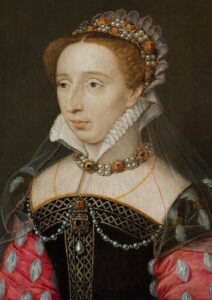 The instruments created for either these celebrations or by order of King Henry II would have been made to be kept in France. This is how Diane of France became be the owner and player of this viola da braccio. One of the larger signifiers of this instrument belonging to her are the carnation flowers painted in the corners, or as they’re named in Latin, Dianthus.
The instruments created for either these celebrations or by order of King Henry II would have been made to be kept in France. This is how Diane of France became be the owner and player of this viola da braccio. One of the larger signifiers of this instrument belonging to her are the carnation flowers painted in the corners, or as they’re named in Latin, Dianthus. 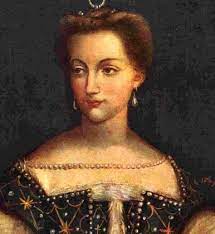
Diane de France (pictured left) was the daughter of King Henry II and one of his mistresses Fillipa Duci de France. Diane was raised under the care of Diane de Poitiers (pictured right), the favorite mistress and long-term partner of King Henry II. Diane de France grew up with staff and tutors. She mastered all the French court languages as well as the viola and the keyboard. This Amati lira da braccio would have accompanied her throughout her youth in 16th century France. Diane de France went on to become the Duchess of Angoulême and build the Hôtel d’Angoulême, now the Hôtel Lamoignon. She would remain in good favor with the French Kings and court until her death in 1619.
AB: What songs do you image Diane de France may have played on this instrument?
AD: Chansons de court, these are some of the first examples of block printed music for public consumption and practice.
Images from Google Books, click on the image to be directed to the page:
Andrew Gonzalez, the violist of the Jasper String Quartet, played this lira da braccio at Givens Violins in June of 2022.
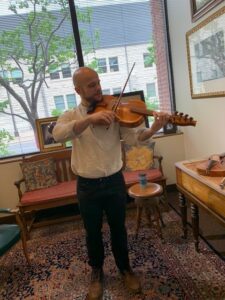
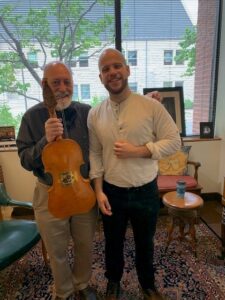
If you are interested in learning more about this historic instrument and the reconstruction Andrew Dipper has made, contact us at cgivens@givensviolins.com or call 612.375.0708. If you are interested in viewing a lira da braccio in-person, you can visit the National Music Museum, an appointment is required. Additionally, if you are interested in viewing a viola da braccio, you may make an appointment with the Metropolitan Museum.
References:
- Laurence C. Witten II (page 7) Apollo, Orpheus, and David, pages 5-55, Journal of the American Musical Instrument Society, Volume 1, 1975.
- Benjamin Hebbert, “Andrea Amati and the Spanish Set.” Violins and Violinists, Accessed 26 March 2024. https://violinsandviolinists.com/2024/03/08/andrea-amati-and-the-spanish-set/
- “Henry II of France.” Wikipedia, Wikimedia Foundation, 17 March 2024, https://en.wikipedia.org/wiki/Henry_II_of_France
- “Diane de France.” Wikipedia, Wikimedia Foundation, 6 November 2023, https://en.wikipedia.org/wiki/Diane_de_France
- “Diane de Poitier.” Wikipedia, Wikimedia Foundation, 23 March 2024, https://en.wikipedia.org/wiki/Diane_de_Poitiers
- “Viola” National Music Museum eCollection website. Accessed 23 March 2024. https://emuseum.nmmusd.org/objects/16804/viola?ctx=07e7f90b-0846-446f-9dfb-b997d605068c&idx=9

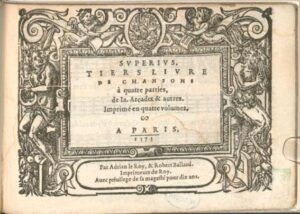
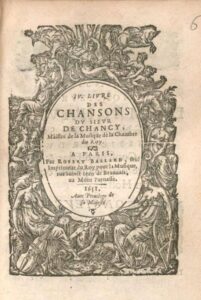
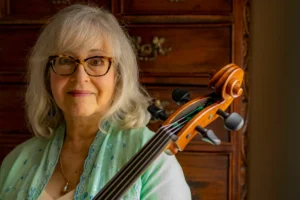
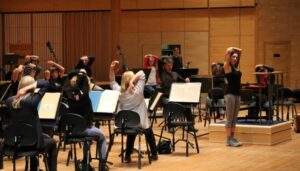
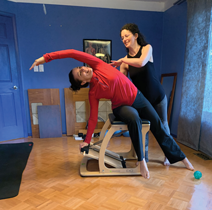 In addition to small stretches on-stage, our off-stage habits can aid greatly in how our bodies store this tension. Stretching at home, practicing yoga or Pilates, finding a physical therapist.
In addition to small stretches on-stage, our off-stage habits can aid greatly in how our bodies store this tension. Stretching at home, practicing yoga or Pilates, finding a physical therapist.
